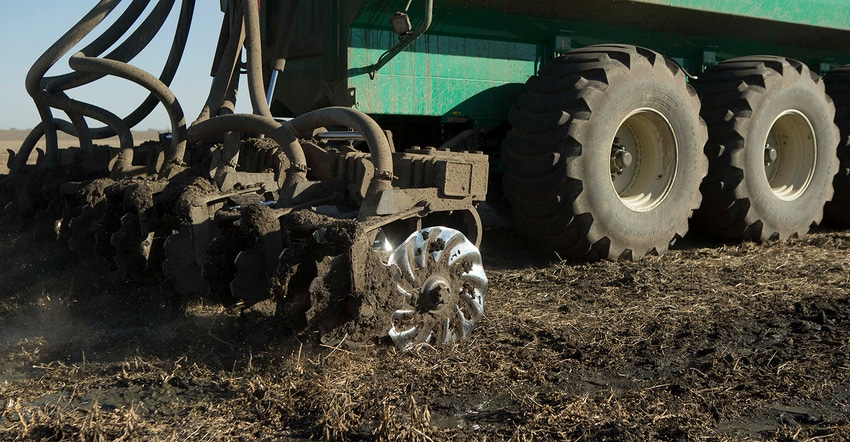Soil doesn't get better by chance, it gets better by change
UNL livestock bioenvironmental engineer details how manure can improve resilience of crop land.

Manure might not be the first thing that comes to mind when one hears the expression, "one man's trash is another man's treasure," but Amy Schmidt says when applied correctly, livestock manure can provide both immediate and long-term benefits to a cropping system.
"We don't necessarily think about, in terms of farm value and in terms of manure value, how manure impacts the soil and the quality of the crop land and the value of the crop land, because it's really hard to measure that, to assign a monetary value to it and some of the changes that contribute to land value don't happen quickly," Schmidt says. "But if you think of land, specifically the soil within a field, do you believe your crop land is resilient? A lot of times we hear that in relation to climate change, is your operation resilient to changing weather conditions? I would also say is your system healthy and is it delivering the greatest possible value to your cropping system?"
During the virtual Nebraska Pork Expo this month, the University of Nebraska-Lincoln livestock bioenvironmental engineer shared how manure has a valid role in improving the resilience of crop land, including its ability to respond to external disruptions such as flooding, erosion, runoff and drought.
"Some of the things that manure can impact are the potential moisture holding capacity of soil, which also can impact the potential for erosion and runoff; the permeability of soil; the nutrient cycling process within soil; and efficiency of the soil in delivering plant available nutrients to crops," Schmidt says. "A lot of these characteristics in the long term are going to be important to the resilience of that cropping system and maybe the value of the land itself down the road."
The first place to start in understanding that value is getting an adequate sample for analysis. For a deep pit system like on many swine farms in Nebraska and elsewhere, Schmidt says multiple samples should be collected over time during agitation and pumping of the manure for land application. Collecting samples annually should provide a consistent estimate of manure volume and total nutrients available for application each year if an operation isn't making changes to their feed or water use. She notes that it's important to keep samples cool and submit them to a lab quickly to maintain the quality of the sample. A value for the manure can then be calculated based on how much of each nutrient is present and what the current market prices are for the different crop nutrients.
For example, Schmidt says one 2,400-head finisher unit with deep pit manure storage, on an annual basis could meet the nitrogen needs of about 240 acres of corn with the manure that is produced from those animals. Based on an assumed fertilizer cost of $125 per acre for corn production, the value of the nutrients that are in that manure could be as much as $30,000 per year.
One important consideration for maximizing the value of land-applied manure is to match the manure content with the needs of the cropland. For example, if a field does not need phosphorus, then you can't really assign any value to phosphorus being applied in the manure. Schmidt focuses on ways to maximize manure value when selecting fields for application.
"We want to target fields that are low in phosphorus, or that have higher phosphorous requirements. For instance, corn silage removes a significant amount of phosphorus because the majority of the plant is removed from the field during harvest," Schmidt says.
The same can be said with potash, she says.
"If we can apply manure to a field where potash is needed, then we can assign some value to the potash in that manure," Schmidt says. "Otherwise, it's there, it factors into the overall value of the manure as it sits in the storage, but it doesn't factor into the value of it as a fertilizer on that field."
Since producers typically apply manure on a nitrogen basis, Schmidt says conserving ammonium nitrogen by injecting manure below the soil surface during application is critical and applying manure ahead of non-legume crops also maximizes nitrogen value.
She says there are also more abstract benefits from manure.
"In terms of the value of manure to soil health, typically we think about the organic matter and microbes that manure contributes to soil. There are also microbes already in the soil, and when manure is added to soil, microbes utilize the organic matter as a food source," Schmidt says. "When a food source is introduced, soil microbes are happy."
As they start consuming and breaking down that organic matter, the microbes produce a byproduct, polysaccharide, a sticky substance that causes the soil particles to stick together. The tiny soil particles then form bigger aggregates and when those larger soil aggregates start forming, the soil is less prone to run off and erosion, and typically has better infiltration rates, Schmidt says.
"If we want to capture the value of manure to soil health, we want to look for finer-textured soils, those with lower organic matter content, or fields experiencing issues like crusting, ponding, runoff and erosion," Schmidt says.
Finally, when it comes to organic fertilizer versus inorganic fertilizer, Schmidt says they're both going to provide nutrients, but the one major difference is the perceived convenience of ordering fertilizer versus purchasing manure, getting an analysis, applying it and the costs associated with it.
"One thing I would say is that the plants don't know the difference, whether inorganic nitrogen comes from an organic fertilizer source or an inorganic fertilizer source," Schmidt says. "The plant doesn't know, but the soil absolutely does know, and the soil is what's going to offer the greatest return on investment beyond nutrients."
About the Author(s)
You May Also Like





